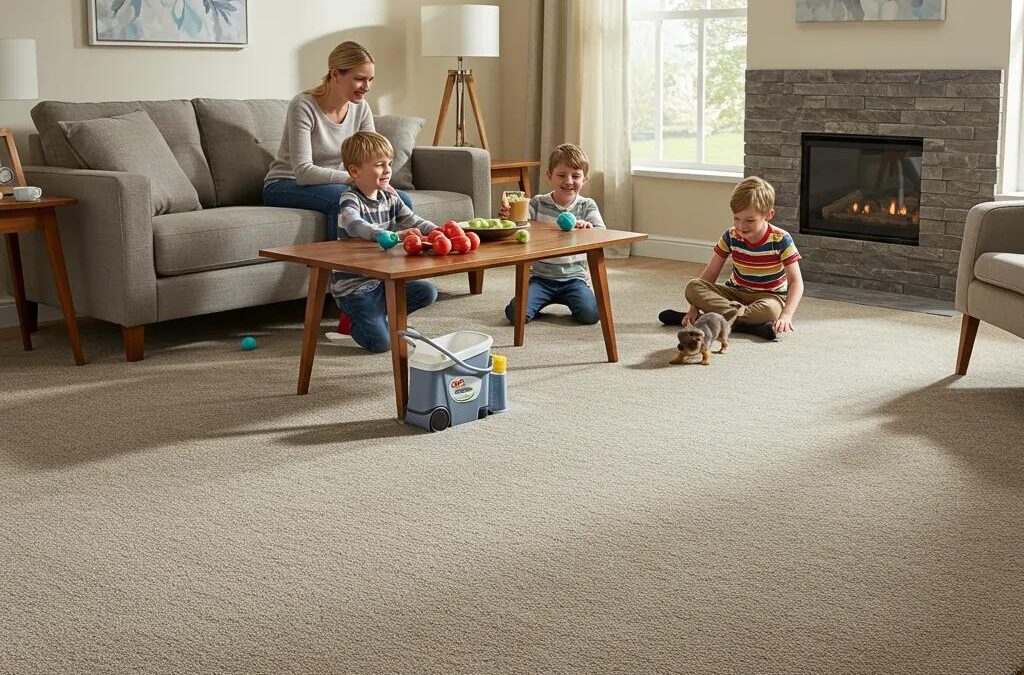Regularly scheduled carpet cleaning is essential to maintain appearance, protect health, and extend the life of your investment. Establishing an optimal carpet maintenance schedule hinges on factors like foot traffic, household makeup, carpet fiber, and Oregon’s unique climate. In this comprehensive guide, you’ll discover:
- Key variables that determine professional carpet cleaning frequency
- Ideal intervals for homes—whether you have pets, children, or allergy sufferers
- Recommended schedules for commercial settings across Oregon cities
- Tangible benefits of hiring experts instead of DIY methods
- Actionable signs that indicate it’s time to call a professional
- Between-service maintenance tips to keep carpets looking their best
- How Carpet MD customizes cleaning plans for Forest Grove, Hillsboro, Beaverton, McMinnville, Sherwood, Tigard, Banks, and North Plains
- Common questions homeowners and businesses ask about carpet cleaning frequency
By the end of this article, you’ll have a clear, science-backed carpet cleaning frequency plan that safeguards indoor air quality and protects your flooring investment.
What Factors Determine How Often You Should Clean Your Carpets?
Determining your carpet cleaning frequency requires weighing multiple variables that influence soil accumulation and fiber wear. Understanding these factors will help you tailor a carpet maintenance schedule that balances cleanliness, health, and cost-effectiveness.
How Does Foot Traffic Affect Carpet Cleaning Frequency?
Foot traffic level describes how many people walk across a carpeted area daily and directly impacts soil embedment and fiber abrasion.
- High-traffic zones like entryways and hallways accumulate dirt up to four times faster than low-traffic rooms.
- Medium-traffic areas (living rooms, dens) see regular use and require moderate cleaning.
- Low-traffic spaces such as guest rooms can go longer between professional treatments.
Carpets in high-traffic areas typically benefit from quarterly deep cleaning, whereas low-traffic rooms often follow a 12–18-month cycle. Recognizing foot traffic patterns establishes the foundation for your service plan.
Why Do Pets and Children Increase Carpet Cleaning Needs?
Pet fur, dander, and occasional accidents introduce organic matter and stains that accelerate fiber soiling and odor retention. Similarly, children track food particles, spills, and outdoor debris onto carpets.
- Pet stains can harbor bacteria and require specialized enzymatic treatments.
- Tracked-in soil from little feet often contains sugars and oils that bond to carpet fibers.
- Odors from pet accidents and spills become more challenging to eliminate over time.
Homes with both pets and children typically need professional cleaning every 3 to 6 months to maintain optimal indoor air quality and prevent permanent discoloration.
How Do Allergies and Indoor Air Quality Influence Cleaning Schedules?
Carpets act as filters, trapping allergens like dust mites, pollen, and pet dander. Regular deep extraction improves air purity and reduces allergy triggers throughout a home or office.
- Professional hot-water extraction removes up to 90% of embedded allergens.
- Thorough cleaning enhances HVAC efficiency by reducing recirculated particulates.
- Allergy sufferers often experience symptom relief after carpet treatments.
Allergen Reduction in Carpets and Furnishings
A study by Airmid Health group demonstrated that a proprietary hot water extraction process significantly reduces allergens in carpets and soft furnishings. Surface levels of dust mite, cat, and dog allergens were reduced by up to 97%. This process also led to a marked reduction in airborne cat allergen exposure and airborne mold.
For households with allergy or asthma concerns, scheduling service every 6 to 9 months ensures a healthier indoor environment and consistent dust-mite reduction.
What Role Does Carpet Type and Material Play in Cleaning Frequency?
Different carpet fibers vary in stain resistance, soil adhesion, and durability. Matching cleaning intervals to fiber type preserves appearance and performance.
| Carpet Material | Typical Cleaning Interval | Primary Reason |
|---|---|---|
| Nylon | 12–18 months | Durable and stain-resistant but benefits from periodic deep cleaning |
| Polyester | 9–12 months | Prone to oil-based stains that embed without professional extraction |
| Wool | 6–12 months | Natural fiber with high absorbency requiring gentle, frequent care |
| Olefin (Polypropylene) | 9–15 months | Moisture-resistant but attracts dirt electrostatically |
Selecting the right interval based on fiber characteristics minimizes wear and prolongs carpet life.
How Does Oregon’s Local Climate Impact Carpet Cleaning Frequency?
Oregon’s rainy seasons and pollen peaks deposit moisture and natural particulates onto carpets, increasing soil buildup and mildew risk.
- Fall rains track mud and organic debris indoors, warranting a late-fall cleaning.
- Spring pollen can settle into fibers, exacerbating allergies without prompt extraction.
- Dry summer months generate fine dust that clings to carpet backing.
Accounting for seasonal environmental loads, scheduling deep cleaning in early spring and late fall aligns carpet maintenance with local climate cycles.
What Is the Recommended Carpet Cleaning Frequency for Residential Homes?
A well-crafted residential cleaning schedule combines average guidelines with adjustments for household dynamics. Following targeted intervals helps maintain carpet health without unnecessary expense.
How Often Should Homes Without Pets or Children Clean Carpets?
In minimal-use households, routine vacuuming supplemented by professional cleaning every 12 to 18 months keeps carpets fresh and prevents gradual soil compaction. Moderate foot traffic and absence of organic stains allow a longer cycle between deep extractions.
What Is the Ideal Cleaning Schedule for Homes with Pets?
When pets share indoor spaces, carpets experience frequent dander, hair, and accidental moisture exposure. Professional treatment every 3 to 6 months eliminates embedded pet allergens and prevents lingering odors, preserving both fiber integrity and air quality.
How Often Should Homes with Children or Allergy Sufferers Clean Carpets?
Homes with children or allergy-prone occupants should schedule carpet cleaning every 6 to 9 months. This interval strikes a balance between allergen removal—dust mites, pollen, and pet dander—and maintaining stain-resistant treatments over time.
IICRC Recommendations for Carpet Cleaning Frequency and Lifespan
The Institute of Inspection, Cleaning and Restoration Certification (IICRC), a leading industry body, provides guidelines for carpet cleaning frequency. They recommend professional cleaning every 6 to 12 months for homes with children, and every 3 to 6 months for homes with pets or heavy soil. Additionally, the IICRC has found that professionally cleaned carpets can last up to twice as long as those cleaned by homeowners, thereby extending their lifespan.
How Does High Foot Traffic in Residential Areas Affect Cleaning Intervals?
Properties with large families or frequent guests see carpets wearing down faster. For hallways, family rooms, and entryways, quarterly or semi-annual professional cleaning prevents soil from cutting fiber strands and flattens nap, ensuring long-term appearance retention.
What Are the Best Seasonal Times for Residential Carpet Cleaning in Oregon?
Timing deep cleaning around local weather patterns maximizes effectiveness:
- Early Spring — Removes winter salts and fine dust before pollen season
- Late Fall — Cleans mud and organic debris tracked indoors after rainy months
- Mid-Summer (optional) — Addresses accumulated dust in drier periods
Aligning service with these seasonal peaks reduces the need for spot treatments and maintains fresh indoor air.
How Often Should Commercial Carpets Be Professionally Cleaned?
Commercial environments demand more frequent cleaning due to constant foot traffic, brand image considerations, and hygiene regulations. A customized service plan ensures safety, comfort, and a professional appearance.
What Cleaning Frequency Is Recommended for Office Carpets in Oregon Cities?
Offices in Forest Grove, Hillsboro, and Beaverton typically schedule professional carpet cleaning every 6 to 12 months. High-traffic lobbies or conference rooms may require quarterly treatments to maintain a crisp, welcoming look.
How Often Should Restaurants and Food Service Areas Clean Carpets?
Restaurants and cafes contend with spills, food debris, and grease. Monthly or quarterly cleaning eliminates staining agents and bacterial risks, ensuring compliance with health codes and enhancing customer perception of cleanliness.
What Are the Cleaning Guidelines for Schools and Daycares?
Daycares and schools house children who spill snacks and track outdoor dirt. Monthly cleaning in classrooms and common areas reduces allergy triggers and bacterial loads, supporting a healthier learning environment.
How Frequently Should Retail Stores and Medical Facilities Schedule Carpet Cleaning?
Retail stores benefit from quarterly or biannual cleaning to showcase products in a pristine setting. Medical offices and clinics often require monthly to quarterly deep cleaning to meet strict sanitation standards and protect patient health.
How Does Foot Traffic and Business Type Influence Commercial Cleaning Schedules?
| Business Type | Recommended Frequency | Operational Rationale |
|---|---|---|
| Large Retail | Quarterly | High foot traffic and image maintenance |
| Healthcare | Monthly | Hygiene compliance and patient safety |
| Corporate Offices | Biannual | Moderate traffic with brand presentation needs |
| Hospitality (Hotels/Lounges) | Quarterly | Guest satisfaction and odor control |
| Educational Facilities | Monthly | Student health and spill management |
Identifying specific industry requirements helps you invest in the right carpet maintenance schedule.
What Are the Key Benefits of Professional Carpet Cleaning Services?
Investing in trained technicians and specialized equipment delivers outcomes beyond what DIY methods achieve. Professional cleaning strengthens carpet resilience and supports a healthier environment.
How Does Professional Cleaning Improve Indoor Air Quality and Health?
Deep extraction removes up to 90% of allergens, bacteria, and pollutants locked in carpet fibers. By eliminating dust mites, pollen, and mold spores, professional cleaning reduces respiratory irritants and promotes wellness for allergy sufferers.
In What Ways Does Regular Cleaning Extend Carpet Lifespan and Protect Investment?
Embedded grit functions like sandpaper underfoot, degrading fibers over time. Professional hot-water extraction lifts these abrasive particles, preserving pile height and preventing premature matting—ultimately deferring replacement costs.
How Do Professional Services Effectively Remove Stains and Odors?
Specialized stain-removal products target organic and oil-based soils without over-wetting fibers. Enzymatic treatments break down odor-causing molecules, leaving carpets visibly brighter and smelling neutral.
Why Is Professional Equipment and Expertise Superior to DIY Methods?
Carpet MD’s high-pressure, hot-water extraction units deliver deeper penetration and faster drying than rental machines. Certified technicians adjust cleaning agents and techniques to fiber type, ensuring maximum soil removal with minimal risk of damage.
When Should You Call a Professional Carpet Cleaner? Signs Your Carpets Need Attention
Spotting early warning signs prevents escalation of dirt, wear, and health hazards. Proactive inspection can avert costly restorations later.
What Are the Visible Signs of Carpet Wear and Dirt Accumulation?
Dull or matted fibers, uneven shading, and persistent soil lines along traffic lanes indicate that carpets have reached their soil-load capacity and require professional intervention.
How Do Persistent Odors and Allergies Signal Cleaning Needs?
Lingering musty or pet odors often mean bacteria and mold have colonized deep within piles. A sudden uptick in allergy symptoms—sneezing, itchy eyes, or respiratory discomfort—reflects allergen buildup demanding deep extraction.
Why Are Recurring Stains and Matted Traffic Lanes Warning Signs?
Once stains absorb into backing layers, DIY spot treatments may fix the surface but fail underneath. Matted lanes show fiber collapse, which invites further soiling and fiber breakage without restorative cleaning.
How Can Regular Inspections Help Maintain Carpet Condition?
Scheduling semi-annual self-inspections allows you to identify emerging stains, fiber flattening, or odor pockets. Early detection guides targeted professional cleaning that preserves appearance and health parameters.
How Can You Maintain Carpets Between Professional Cleanings?
Routine care bridges the gap between deep-extraction visits, extending intervals and enhancing performance.
How Often Should You Vacuum to Support Carpet Cleanliness?
Daily or at least tri-weekly vacuuming in medium to high-traffic areas prevents soil from embedding. Use vacuums with HEPA filtration and rotating brushes to lift fine particles before they abrade fibers.
What Are the Best Spot Cleaning Practices for Common Stains?
Immediate blotting with a clean, white cloth prevents stain migration. Apply a pH-balanced spot cleaner and gently agitate—never scrub—to lift soils. Rinse with water and absorb excess moisture to avoid residue buildup.
What Are the Risks of DIY Carpet Cleaning and Residue Build-Up?
Over-application of DIY cleaning solutions can leave sticky residues that attract dirt, hastening re-soiling and fiber deterioration. Inadequate rinsing may also trap cleaning agents, causing browning or fiber damage over time.
How Does Carpet MD Provide Customized Carpet Cleaning Schedules for Oregon Residents and Businesses?
Carpet MD pairs local expertise with personalized assessments to create maintenance plans that reflect each client’s unique context and needs.
How Does Carpet MD Tailor Cleaning Frequency Based on Foot Traffic and Usage?
Certified technicians evaluate room function, occupant count, and carpet fiber to recommend intervals—ranging from quarterly for high-use zones to annual for low-traffic rooms—ensuring resources align with performance goals.
What Specialized Services Does Carpet MD Offer for Pet Stains and Odor Removal?
Our enzymatic pet-odor treatment leverages advanced biological agents that neutralize ammonia and organic residues. Post-treatment deodorizing encapsulates remaining odor molecules for prolonged freshness.
How Does Carpet MD Address Unique Commercial Industry Needs in Oregon Cities?
From tech offices in Hillsboro to wineries in McMinnville, we adapt cleaning protocols to industry standards—monthly sanitation in healthcare, quarterly image upkeep in retail, and event-driven schedules for hospitality venues.
Why Choose Carpet MD for Professional Carpet Cleaning in Forest Grove, Hillsboro, and Surrounding Areas?
As a locally owned provider, Carpet MD combines community trust with IICRC-certified technicians, state-of-the-art extraction equipment, and eco-friendly solutions. Our dedication to health, longevity, and aesthetic excellence positions us as the premier carpet care partner in your neighborhood.
What Are Frequently Asked Questions About Carpet Cleaning Frequency?
Homeowners and businesses often seek clarity on service timing, health impact, and fiber safety. Below are concise answers to the most common inquiries.
How Often Should I Professionally Clean My Carpets at Home?
Most homeowners schedule professional cleaning every 12 to 18 months. Those with pets, children, or high foot traffic benefit from a 3 to 6-month interval to preserve appearance and indoor air quality.
How Often Should Commercial Carpets Be Cleaned by Industry Type?
Cleaning frequency varies by sector: healthcare facilities often require monthly service, retail spaces quarterly, and corporate offices biannually to maintain hygiene and brand standards.
Can Regular Carpet Cleaning Improve Indoor Air Quality?
Yes. Professional hot-water extraction removes trapped allergens—dust mites, pollen, pet dander—by up to 90%, significantly reducing airborne particulates and promoting respiratory health.
Does Frequent Professional Cleaning Damage Carpet Fibers?
No. Regular, properly executed deep cleaning actually preserves fiber integrity by eliminating abrasive grit and preventing permanent soiling that causes fiber degradation over time.
What Is the Best Time of Year to Schedule Carpet Cleaning in Oregon?
Early spring and late fall align with seasonal challenges—removing winter salts, mud, and spring pollen—to deliver the most impactful cleaning results.
Maintaining a tailored carpet maintenance schedule unlocks healthier indoor air, extends carpet lifespan, and upholds a professional aesthetic. By aligning service intervals with traffic levels, household dynamics, fiber type, and regional climate, you ensure efficient use of resources and lasting flooring performance. Trust Carpet MD’s local expertise and specialized equipment to craft a cleaning frequency plan—contact us today to schedule your next appointment in Forest Grove, Hillsboro, Beaverton, McMinnville, Sherwood, Tigard, Banks, or North Plains.







